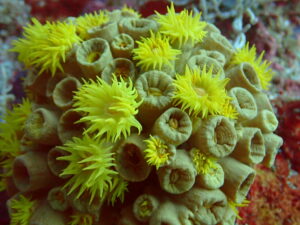Dendrophyllid Stony Corals of the Dendrophylliidae Family
 Orange Cup Coral, Tubastraea coccinea. A representative of the Dendrophyllidae Family of Stony Corals.
Orange Cup Coral, Tubastraea coccinea. A representative of the Dendrophyllidae Family of Stony Corals.
Phylogeny: The Dendrophyllid Corals are a member of the Dendrophylliidae Family of Stony Corals. They fall under the category of hard, or stony corals, and differ from the soft corals, or octocorals. Like sea anemones, jelly fish, and hydroids, are members of Phylum Cnidaria. They are in the Class Anthozoa and the Order Scleractina.
Distribution: Dendrophyllid Corals are found worldwide in tropical waters. The Dendrophylliidae Family has twenty-two with more than one hundred sixty individual species with five species being found along the Pacific Coast of Mexico. These corals are found on hard substrates, from the intertidal zone to depths that exceed 2,165 m (7,100 feet). These corals may be either solitary or colonial.
Morphology: Dendrophyllid Corals have radial symmetry, a hollow digestive cavity, and specialized stinging structures in tentacles surrounding the mouth. They are diverse in shape; the name “dendrophylliid” means “tree-leaf”, and may refer to the branching, tree-shape of some species in this Family. Other species in the Family have completely different shapes, including cave corals, disk corals, cup corals, and lettuce corals. The morphological characteristics of the Family are not particularly useful in the field. One of these characteristics is the arrangement pattern of septa within the polyp. Another characteristic is a porous thecal wall that allows the tissue lining the walls to continue from the outside to the inside. Neither of these characteristics will be obvious in a living specimen. Two helpful traits for many, but not all species in the Family, are fleshy tentacles and large mouths. One trait of dead specimens is a granular skeleton that feels like sandpaper. Dendrophyllid Corals may be small and flattened or have branches reaching 60 cm (2 feet) in length. Some species can form colonies that are several meters in diameter. Only a few species are reef building.
Ecosystem Roles: Dendrophyllid Corals have flower-like polyps that produce a hard, calcareous skeleton. They live in tightly packed colonies with multiple generations built upon the skeletons of previous generations, forming coral reefs. About a dozen species in the Dendrophyllidae Family are zooxanthellate, therefore requiring shallow water with lots of sunlight for photosynthesis. The great majority of the species in the Family are azooxanthellate and live in deeper water or in caves or under overhangs.